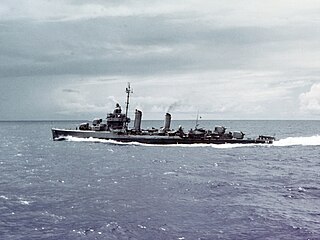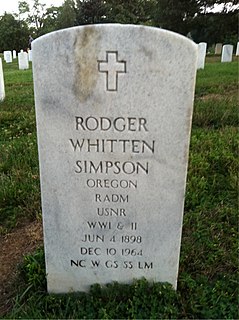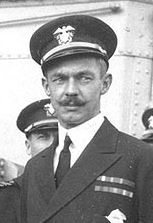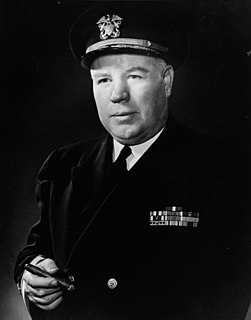Related Research Articles

Norman (Nicholas) Scott was a rear admiral in the United States Navy, and was one of only two U.S. Navy admirals killed in action during a surface battle in World War II. Scott posthumously received the Medal of Honor for his actions in the Pacific Theater of World War II.

USS Doneff (DE-49) was an Evarts-class destroyer escort which served in the United States Navy in the Pacific Theater of Operations. The only encounter with the Imperial Japanese Navy was the sighting of one or two A6M Zero fighters during the operational time spent in the Aleutian Islands. The Chief Yeoman was Arthur E. Brockschmidt, who died on 22 January 2004 in Springfield, Illinois. The executive officer was Lieutenant Commander Herman Talmadge and the deck officer was Lieutenant Junior Grade Robert Guy Shriver.

Robert Pearce Briscoe was an Admiral of the United States Navy. He commanded two ships, a destroyer squadron, and an amphibious group during World War II. He later served as Commander-in-Chief, Allied Forces Southern Europe, from 1956 to 1959. He was a native of Centreville, Mississippi born February 19, 1897, to Pearce and Alice Briscoe.

Charles Turner Joy was an admiral of the United States Navy during World War II and the Korean War. During the last years of his career, while fighting leukemia, he served as Superintendent of the Naval Academy. The destroyer USS Turner Joy (DD-951) was named for him.

USS Trever (DD-339/DMS-16/AG-110) was a Clemson-class destroyer of the United States Navy in commission from 1922 to 1923 and from 1930 to 1945. Converted to a destroyer minesweeper in 1940, she served in the Pacific throughout World War II, including during the Japanese attack on Pearl Harbor, the Guadalcanal campaign, and the New Georgia campaign.

USS Purdy (DD-734), an Allen M. Sumner-class destroyer, is the only ship of the United States Navy to be named for Lieutenant Commander Frederick Warren Purdy, who was awarded the Silver Star for his rescue efforts while the destroyer USS Strong was sinking on 5 July 1943.

USS Edwards (DD-619) was a Gleaves-class destroyer of the United States Navy. She was the second Navy ship named "Edwards", and the first named for Lieutenant Commander Walter A. Edwards (1886–1926), who as commander of Bainbridge in 1922 rescued nearly five hundred people from the burning French transport Vinh-Long. For his heroism Edwards was awarded the U.S. Medal of Honor, the French Légion d'honneur, and the British Distinguished Service Order.

David Worth Bagley was an admiral in the United States Navy during World War II. He was also the brother of Ensign Worth Bagley, the only United States Navy officer killed in action during the Spanish–American War, and the father of Admirals David H. Bagley and Worth H. Bagley.

Rodger Whitten Simpson was a rear admiral of the United States Navy, who distinguished himself during World War II. The frigate USS Simpson (FFG-56) was named in his honor.

Walter Atlee Edwards was a Lieutenant-Commander in the United States Navy and a recipient of America's highest military decoration - the Medal of Honor.

Samuel Glenn Fuqua was a United States Navy rear admiral and a recipient of America's highest military decoration — the Medal of Honor — for his actions in World War II during the attack on Pearl Harbor.

Jack William Wintle was a United States Navy Officer and a posthumous recipient of the Navy Cross, which was awarded for his actions in mid November 1942, during the Battle of Guadalcanal.

Paul J. Register was a United States Navy officer killed in action during the attack on Pearl Harbor for whom two U.S. Navy ships were named.

Bernard Lige Austin was a Vice Admiral of the United States Navy. His career included service in World War II, the Korean War, and the Cold War and command of submarines and surface ship forces, during which he became a distinguished combat commander of destroyers. He also commanded the United States Second Fleet, held numerous diplomatic, educational, and administrative staff positions, and a served a lengthy tour of duty as President of the Naval War College.

Benedict Joseph Semmes Jr. was a vice admiral of the United States Navy. His career included service in World War II and the Cold War, command of destroyers, a lengthy tour as Chief of Naval Personnel, command of the United States Second Fleet, duty as Deputy Chief of Naval Operations, and a tour as President of the Naval War College.

Francis Xavier McInerney was a United States Navy Vice admiral, Navy Cross recipient, Silver Star recipient and namesake of USS McInerney (FFG-8).

George Philip Jr. was a United States Navy Commander and recipient of the Navy Cross and Silver Star. He died during a kamikaze attack while commanding USS Twiggs (DD-591). The Oliver Hazard Perry-class frigate USS George Philip (FFG-12) was named in his honor.
Harry Bean Jarrett was a United States Navy Vice Admiral. He received a number of awards for valor during World War II and was the namesake of USS Jarrett (FFG-33).

Rear Admiral Frederick Julian Becton was a decorated United States Navy officer. He is probably best remembered for commanding the destroyer USS Laffey (DD-724) in World War II during an intense Japanese kamikaze attack.

Vice Admiral Edmund Battelle Taylor was an admiral in the United States Navy. During World War II he saw service in the fighting in the Pacific, including the Battle of Cape Esperance, in which his ship, the USS Duncan was sunk, the Battle of Empress Augusta Bay and the Battle of the Philippine Sea. In the last months of the war he was the naval aide to the Secretary of the Navy, James Forrestal. After the war he commanded the Guantanamo Bay Naval Base and was commander of the Antisubmarine Defense Force, Atlantic Fleet, during the Cuban Missile Crisis.
References
- This article incorporates text from the public domain Dictionary of American Naval Fighting Ships .